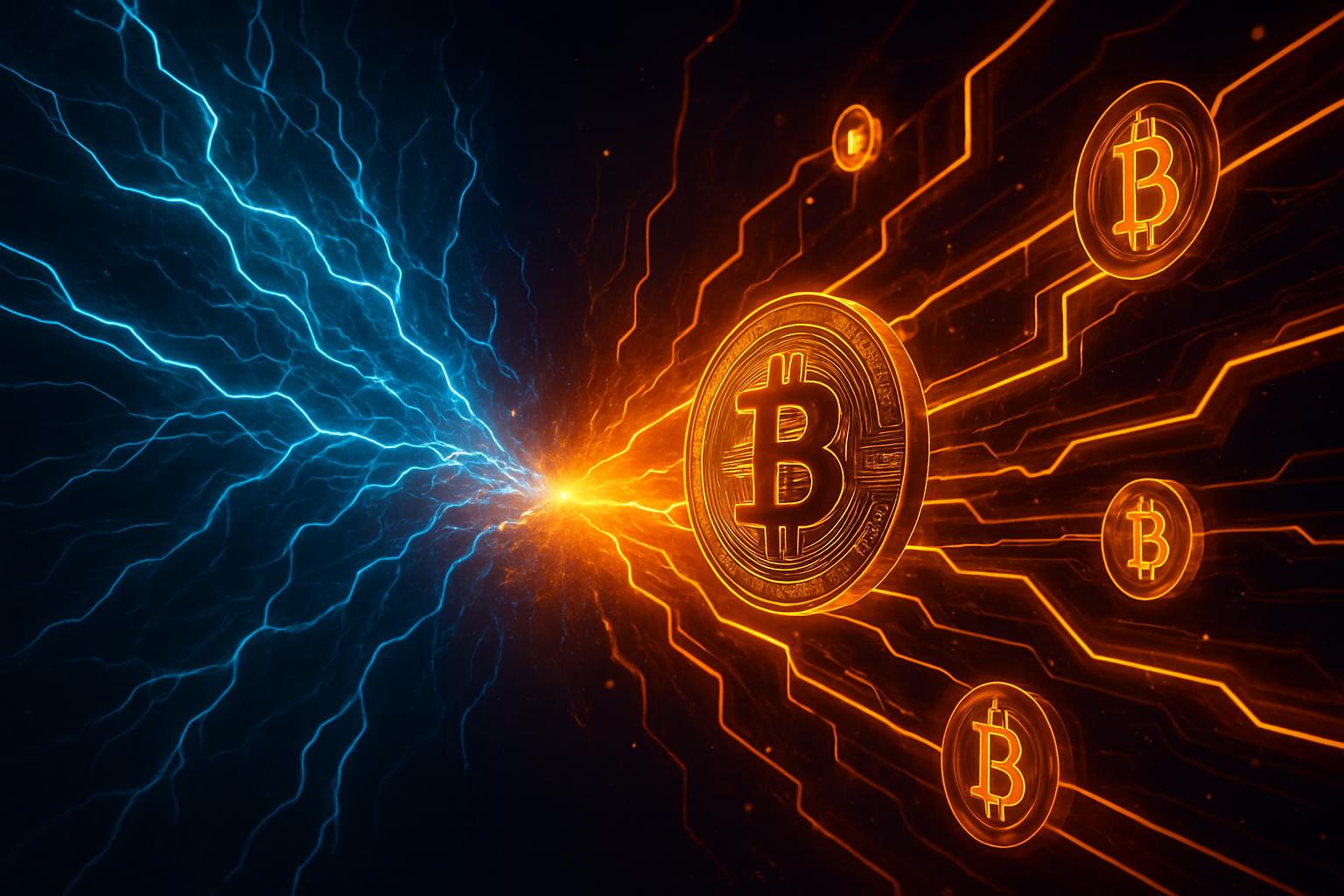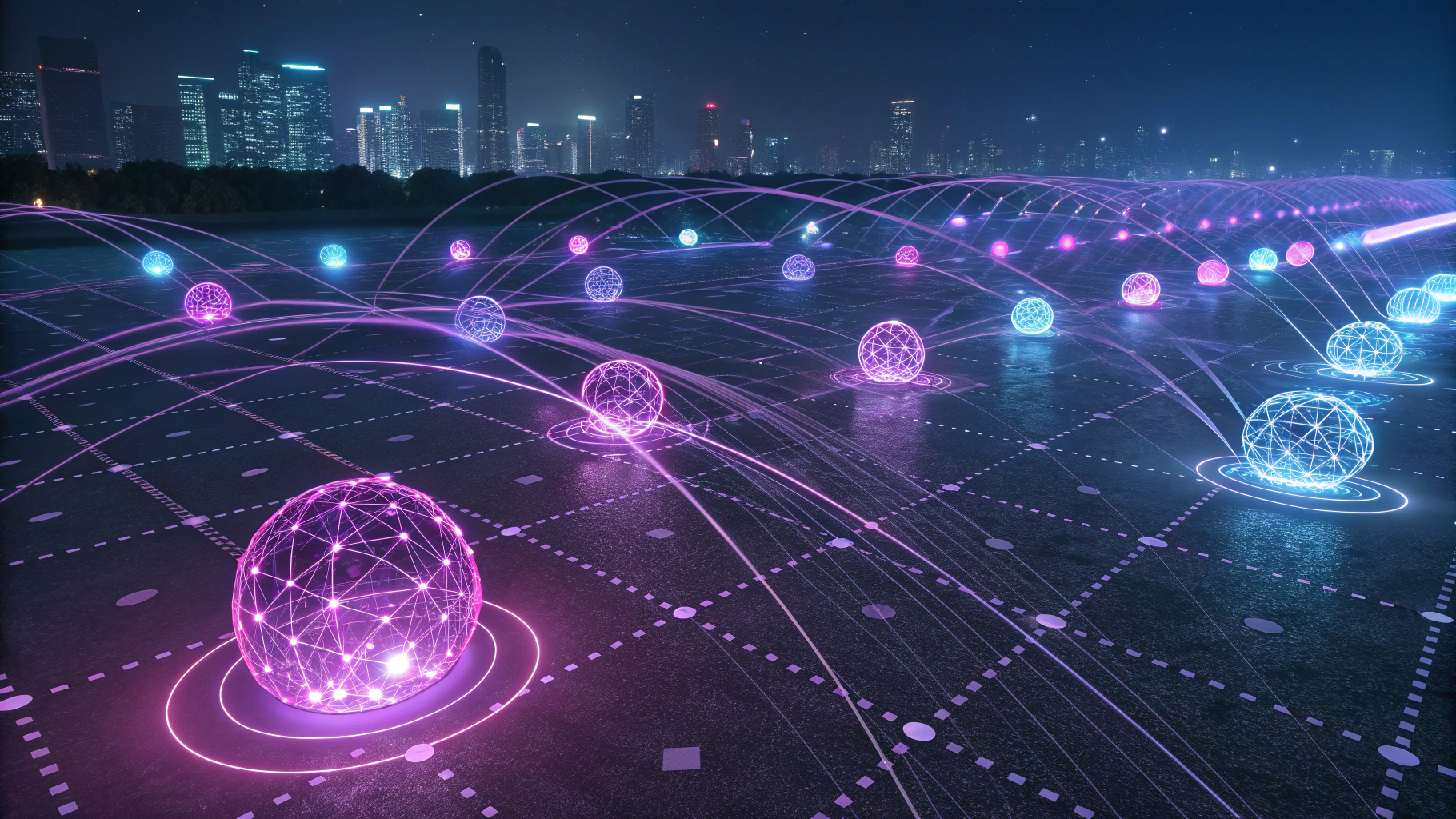AI Agents vs Bitcoin Speed: The $335B Clash Ahead – Can It Handle AI Economy?

Part I: The New Machine Economy: AI Agents Take the On-Chain Stage
As of October 2025, the digital asset landscape is being reshaped by the collision of two monumental forces. The first is a technological supernova: the explosive, near-vertical ascent of autonomous Artificial Intelligence (AI) agents operating directly on public blockchains. This isn’t a future hypothetical; it’s a present-day reality—a “Cambrian explosion” of on-chain intelligence rapidly forming the bedrock of a new machine-to-machine economy. The second is a classic market phenomenon: a roaring Bitcoin bull market, driven by institutional capital and favorable macroeconomic winds, which has pushed the asset to new all-time highs.
These two narratives, seemingly parallel, are on a collision course. The burgeoning AI economy, predicated on high-frequency, low-cost interactions, is making an unprecedented demand on its chosen settlement layer. Yet Bitcoin, the most secure and valuable digital asset, was designed for the exact opposite: deliberate slowness, finality, and security above all else. This report dissects this profound mismatch—the central conflict between the needs of a new, high-velocity machine economy and the inherent limitations of Bitcoin’s base layer. It is a technological and economic paradox forcing a reckoning within the Bitcoin ecosystem and creating one of the most significant investment theses of the modern era.
The Cambrian Explosion of On-Chain Intelligence
The year 2025 has unequivocally become “the year of the agent,” as a niche intersection of AI and blockchain erupted into the market’s hottest narrative. The economic scale of this shift is staggering: according to a 2025 analysis of autonomous crypto trading, the market cap for AI-specific tokens surged from $23 billion to over $50.5 billion in just eight months, with the dedicated agent sector hitting a $5.38 billion valuation. This isn’t just speculation; it’s a fundamental shift in user behavior. On-chain AI activity has surged 86%, now accounting for a remarkable 19% of all engagement in the Web3 space, as detailed in Encanto Technologies’ report on AI’s disruption of finance.
This new ecosystem is not monolithic. It is a complex, multi-layered stack comprising foundational protocols, development frameworks, and a diverse array of specialized, autonomous agents already performing complex tasks on-chain.
The Vanguard of On-Chain AI
The landscape is populated by a range of projects, each tackling a different component of the decentralized AI stack. Foundational platforms like Bittensor (TAO) and data indexing protocols like The Graph (GRT) are creating peer-to-peer markets for intelligence, while Layer-1s such as NEAR Protocol provide the scalable infrastructure for AI-driven dApps, as highlighted in a 2025 market analysis of AI crypto coins. A pivotal development has been the formation of the Artificial Superintelligence Alliance, a merger of leading projects detailed by Crypto.com as a key token to watch. Fueling this growth are agent launchpads like Virtuals Protocol (VIRTUAL), which, according to Bolder Group’s insights on the rise of crypto AI, now hosts over 13,000 distinct AI agents. Frameworks like ElizaOS provide foundational tools, while the proliferation of no-code platforms is rapidly lowering the barrier to entry, a trend explored in this 2025 guide to AI agents in crypto.
These are not simple bots; they are sophisticated, autonomous entities operating their own wallets and interacting securely with decentralized protocols. In decentralized finance (DeFi), agents like Vader.ai and AI16Z are already redefining asset management by autonomously managing portfolios, executing complex trading strategies, and optimizing yield farming positions without human intervention. In market intelligence, agents like AIXBT have become influencers, amassing over 450,000 followers by analyzing and reporting on market sentiment. Other agents perform highly specialized functions, such as H4CK, an ethical hacking agent that identifies protocol vulnerabilities for bug bounty rewards.
The critical takeaway is their transactional nature. Their operations are a continuous stream of micro-interactions, creating an immense demand for a payment rail that can support an extremely high volume of near-instant, low-cost micropayments, a concept detailed in HyperCycle’s core whitepaper. Projections suggest transaction volume among AI agents is set to be over 100 times larger than that among humans, as each individual may eventually command multiple agents transacting at a frequency far exceeding human capacity, a future envisioned by the creators of the YKILY Network. This is the economic engine driving the need for a new financial infrastructure.
| Project/Token | Category | Primary Function | Market Cap (Oct 2025 Est.) |
|---|---|---|---|
| Bittensor (TAO) | Decentralized AI Marketplace | Creates a peer-to-peer intelligence market, incentivizing ML models to contribute to a collective network. | ~$2.2 Billion |
| Artificial Superintelligence (FET) | Decentralized AI Infrastructure | A merger of Fetch.ai, SingularityNET, and Ocean, providing a framework for autonomous economic agents and data sharing. | ~$1.5 Billion |
| Virtuals Protocol (VIRTUAL) | Agent Launchpad & Framework | A platform for creating, deploying, and co-owning tokenized AI agents, hosting over 13,000 agents. | ~$800 Million |
| NEAR Protocol (NEAR) | L1 for AI | A scalable, carbon-neutral blockchain designed to support high-throughput dApps, including those with AI functionalities. | ~$12 Billion |
| The Graph (GRT) | Data Indexing | A decentralized protocol for indexing and querying data from blockchains, essential for data-hungry AI agents. | ~$2.0 Billion |
| Table 1: The On-Chain AI Vanguard: Leading Projects in 2025. Market caps are estimates based on available 2025 data. |
Bitcoin in the Fast Lane: A Market at All-Time Highs
Simultaneously, Bitcoin is experiencing a powerful bull market. On October 6, 2025, the price surged to a new all-time high of $126,200 before a slight pullback to its current trading range around $124,000. This marks a staggering 100% gain year-to-date, fueled by renewed institutional adoption and bullish forecasts from major financial institutions like Standard Chartered, which, as Finance Magnates reports, projects a year-end price target between $180,000 and $200,000. Bitcoin’s total market capitalization now stands at a formidable $2.48 trillion, cementing its status as a globally significant macroeconomic asset, according to the latest data from Blockchain Council. The positive sentiment is broad-based, lifting major altcoins and signaling the potential onset of a market-wide “altcoin season.”
However, on-chain data presents a more nuanced picture. While the price is at its peak, there are signs of profit-taking. In early October, on-chain analysts at TradingView noted a significant movement of 32,322 BTC (worth ~$3.93 billion) from wallets dormant for three to five years. This suggests that some of the market’s most patient “whales” are beginning to realize gains, a potential indicator of forthcoming volatility.
The Great Divide: Bitcoin’s Speed Problem vs. AI’s Need for Now
Herein lies the central conflict. The on-chain AI economy is fundamentally predicated on speed, volume, and low cost. Autonomous agents require payment rails that can settle transactions in sub-seconds for fractions of a cent—the world of machine-to-machine (M2M) micropayments.
Bitcoin’s base layer is, by design, the antithesis of this. It was architected for security, not velocity. The network’s performance metrics starkly illustrate this divide. The average time to generate a new block is approximately 10 minutes, with transaction confirmation often requiring multiple blocks, leading to an average settlement time that can range from 10 minutes to over an hour during congestion, according to historical data from YCharts. The network’s throughput is capped at a theoretical maximum of around 7 transactions per second (TPS), a figure dwarfed by modern blockchains like Solana, which can handle thousands of real-time TPS, as tracked by performance dashboards like Chainspect.
| Metric | Bitcoin Network (Layer 1) | Requirement for AI Agents |
|---|---|---|
| Price (ATH) | $126,200 (Oct 6, 2025) | N/A |
| Market Cap | ~$2.48 Trillion | N/A |
| Average Block Time | ~10 minutes | Sub-second |
| Average Confirmation Time | ~10-12 minutes | Near-instant (<1 second) |
| Transactions Per Second (TPS) | ~7 TPS | Thousands to Millions |
| Average Transaction Fee | Variable ($0.86 – $50+) | Fractions of a cent |
| Table 2: Bitcoin Network Performance Snapshot vs. AI Agent Requirements (October 2025). |
This juxtaposition reveals a fundamental paradox. The market celebrates Bitcoin’s all-time high, a valuation driven by a “digital gold” narrative that prizes its deliberate slowness. Yet, a powerful new AI narrative demands the exact opposite: a “programmable money” layer capable of immense velocity. This inherent contradiction is forcing a technological reckoning, compelling the Bitcoin ecosystem to scale or risk ceding the future of on-chain finance to more nimble competitors.
Part II: Converging Paths: A History of Code and Cognition
The current frenzy surrounding on-chain AI agents is not a spontaneous event. It is the culmination of two parallel, decades-long technological revolutions. Understanding the independent histories of blockchain and artificial intelligence is essential to appreciating why their convergence is happening now. This was not a planned marriage but a convergence born of necessity, driven by the inherent limitations of centralized AI and the unique solutions offered by decentralized ledgers, a history chronicled by platforms like BytePlus.
From Cypherpunks to Smart Contracts: The Evolution of Blockchain
The roots of blockchain extend back to the 1980s cypherpunk movement’s focus on cryptography for individual liberty. In the 1990s, researchers Stuart Haber and W. Scott Stornetta developed a cryptographically secured chain of blocks to create tamper-proof document timestamps, laying the direct groundwork for the modern blockchain.
The watershed moment arrived in 2008 with Satoshi Nakamoto’s Bitcoin whitepaper, which introduced a peer-to-peer electronic cash system that solved the “double-spending problem” without a central authority. For years, blockchain was synonymous with Bitcoin. The next evolutionary leap came in 2015 with Ethereum, which introduced “smart contracts”—self-executing code deployed on the blockchain. This innovation marked the beginning of the “Blockchain 2.0” era, transforming the technology from a simple ledger into a global, decentralized computing platform. It was this programmability that opened the door for decentralized applications (dApps), DeFi, and, eventually, the complex logic required to host autonomous AI agents.

From Turing to Transformers: The Unrelenting March of AI
The history of artificial intelligence follows a similarly long path. Theoretical foundations were laid by Alan Turing in the mid-20th century, and the field was formally born at the 1956 Dartmouth Conference, where the term “artificial intelligence” was coined. Early successes like the ELIZA chatbot generated excitement, but computational challenges led to several “AI winters”—periods of reduced funding and interest.
The modern AI renaissance began in the 2010s, propelled by deep learning, massive datasets, and exponential growth in computing power. The most crucial shift for our purposes has been the evolution from passive, model-based AI to active, autonomous “agents.” A traditional AI model is reactive; an AI agent is proactive. It can perceive its environment, set goals, create multi-step plans, and execute them using available tools without direct human command for each step. This transition from automation to autonomy is what makes a native, on-chain economic layer essential. An autonomous agent, operating in a decentralized ecosystem, requires a native, trustless means of value exchange to function, a concept explored by publications like The Block.
The Handshake: When AI Met the Blockchain
The integration of AI and blockchain was a “pull” from the AI community, which was grappling with the crises of centralized control. As AI became more powerful, its development concentrated in the hands of a few tech corporations, creating problems of data monopolies, opaque algorithms, and potential bias, an issue detailed in research from Reflexivity.
The Decentralized AI (DeAI) movement emerged in response, finding a natural ally in blockchain’s core principles of decentralization, transparency, and user ownership, which offered a compelling solution to the problems plaguing centralized AI. Key milestones mark this convergence:
- 2016: The Dawn of DAOs. The first Decentralized Autonomous Organizations on Ethereum demonstrated how smart contracts could automate complex governance, a precursor to agent-based systems.
- 2017–2018: The Theoretical Foundation. The first academic papers exploring AI-blockchain synergies were published, and decentralized AI marketplaces like SingularityNET began development.
- 2019–2020: Breakthrough Implementations. The ecosystem moved from theory to practice with projects like Ocean Protocol, which created a decentralized data marketplace allowing AI researchers to access and monetize datasets while preserving privacy.
- 2024–2025: The Agent Economy. The technology matured to the point where on-chain agents could be deployed with sufficient autonomy to perform meaningful financial tasks. This created the current, urgent demand for a high-speed, scalable payment infrastructure to serve as the economic backbone for this new machine-to-machine economy.
The demand for blockchain infrastructure from the AI community is therefore a foundational requirement to build a more trustworthy and equitable AI paradigm, making the trend more durable than fleeting market hype.
Part III: Scaling the Summit: The Race to Build Bitcoin’s High-Speed Rails
The collision between the high-velocity demands of the AI economy and the methodical pace of Bitcoin’s base layer has ignited a fierce innovation race. The challenge is clear: build a transactional layer on top of Bitcoin that offers sub-second settlement and near-zero fees without compromising the core network’s unparalleled security.
Lightning Strikes: Bitcoin’s Premier Payments Layer Under the Microscope
The Lightning Network is Bitcoin’s most established Layer-2 scaling solution, designed for fast, low-cost payments. It operates via “state channels,” allowing users to transact off-chain an unlimited number of times with near-instant settlement for fees of just fractions of a cent. In theory, its architecture allows it to scale to millions of transactions per second, making it the prime candidate to serve the M2M micropayments required by AI agents, a potential outlined in price forecasts and analyses of the network.
Evidence supports Lightning’s growth. Reports from early 2025 indicate a potential user base of over 650 million people, driven by integrations with major apps like Coinbase and Cash App. The economic activity is substantial; some trading platforms on Lightning process over $1.5 billion in monthly volume, and professional node operators like Block have disclosed earning yields as high as 9.7% from routing payments, as reported by Bitcoin Magazine. A pivotal development was the rollout of Taproot Assets, enabling stablecoins like Tether (USDT) on Lightning, which could dramatically expand its utility into a multi-asset settlement infrastructure.
However, this bullish narrative is complicated by contradictory on-chain data. Public metrics show a “sustained slide” in the network’s visible footprint. Total Bitcoin capacity in public channels has declined 30-35% from its 2024 peak, and the number of public channels has been halved from over 80,000 to just over 41,700, a trend analyzed by CryptoSlate.
This discrepancy doesn’t signal a network in decline but one that is maturing. Experts attribute this to a consolidation of liquidity into fewer, larger, professionally managed hubs—the top ten operators now control ~62% of public capacity. There is also a growing preference for private channels and more efficient capital use via protocol enhancements. The conclusion is that Lightning is evolving, but this evolution comes with a critical trade-off: increasing centralization of liquidity, which runs counter to the decentralized ethos required for a truly autonomous AI economy.
Beyond Lightning: The Rise of Programmable Bitcoin L2s
While Lightning is hyper-optimized for payments, a new class of Bitcoin Layer-2s has emerged to add programmability. These platforms aim to bring the smart contract functionality of blockchains like Ethereum to Bitcoin, a crucial component for the complex logic of advanced AI agents, as explored in MEXC’s overview of the L2 landscape.
This has resulted in a bifurcation of the Bitcoin L2 landscape into two camps: payments and programmability. An advanced AI agent requires both, creating a fragmentation problem. It must bridge assets and logic between different L2s, introducing complexity and risk that doesn’t exist on integrated platforms like Solana or Ethereum. This could be a significant disadvantage for Bitcoin in the race to become the AI economy’s settlement layer.
Leading programmable L2s employ different technologies, with a comparative analysis available on platforms like BingX Academy:
- Stacks (STX): A sidechain using Proof-of-Transfer (PoX) to link its security to Bitcoin, enabling smart contracts and securing over $208 million in Total Value Locked (TVL).
- Rootstock (RIF): An EVM-compatible sidechain secured through “merged mining,” allowing Ethereum developers to easily port their applications.
- Merlin Chain (MERL): An EVM-compatible ZK-Rollup that experienced explosive growth, surpassing $1.7 billion in TVL by August 2025.
- Hemi (HEMI): A modular L2 with a novel VM that has also seen rapid adoption, securing over $1.2 billion in TVL.
| Solution | Technology | Primary Use Case | Transaction Speed | TVL (Oct 2025 Est.) |
|---|---|---|---|---|
| Lightning Network | State Channels | Instant Micropayments | Near-Instant (<1s) | N/A (Capacity: ~3.85k BTC) |
| Stacks (STX) | Sidechain (PoX) | Smart Contracts, DeFi, NFTs | Slower (Tied to Bitcoin blocks) | ~$208 Million |
| Rootstock (RIF) | Sidechain (Merged-Mined) | EVM-Compatible dApps | ~30 seconds per block | ~$150 Million |
| Merlin Chain (MERL) | ZK-Rollup | EVM-Compatible dApps, BTCFi | Fast (Seconds) | ~$1.7 Billion |
| Table 3: Bitcoin Layer-2 Solutions: A Comparative Analysis. TVL figures are based on the latest available 2025 data. |
The Trillion-Dollar Question: Sizing the On-Chain AI Economy
Quantifying the future economic impact of the “Blockchain AI” market is a challenge, reflected in wildly divergent forecasts. This wide range indicates a nascent, speculative, yet universally high-growth sector.
- Precedence Research projects the market to grow from $680 million in 2025 to $4.3 billion by 2034, a CAGR of 22.93%.
- SkyQuest Technology offers a similar outlook, estimating growth from $561 million in 2024 to $3.4 billion by 2032, a CAGR of 25.3%.
- Market Research Future presents a more aggressive forecast, projecting an expansion from $4.28 billion in 2025 to $70 billion by 2035, a CAGR of 28.93%.
- GMI Research offers the most bullish forecast, estimating the market will surge to $335.8 billion by 2030, implying a massive CAGR of 58.9%.
The discrepancy likely stems from differing market definitions. Lower-end estimates may focus narrowly on AI-specific protocols, while higher-end projections likely assume a broader integration of AI into all facets of the blockchain economy. Regardless, the consistent theme is explosive growth.

The Regulatory Gauntlet: Navigating Autonomous Finance
The single greatest bottleneck to a large-scale on-chain AI economy is the profound lack of regulatory clarity. The legal landscape for autonomous AI agents conducting financial transactions is almost entirely undefined. While agencies like the U.S. Federal Reserve and the CFTC have begun research, they are far from issuing comprehensive guidance.
This challenge strikes at the heart of our legal frameworks, which are built on human agency. Autonomous AI agents break this paradigm, creating a chasm of accountability and formidable legal challenges.
Legal and Compliance Hurdles:
- Liability and Accountability: Who is responsible when an autonomous agent malfunctions? The developer, the user, or the platform? As The National Law Review points out, there is no legal precedent for assigning liability to a non-human entity for financial losses.
- Consumer Protection: Regulators like the U.S. FTC have warned that existing consumer protection laws apply to AI. As legal experts at Fenwick note, false representations about an agent’s capabilities could lead to significant enforcement actions.
- Financial Services Regulation: AI agents performing tasks like lending or credit scoring may fall under existing financial regulations that mandate transparency—a requirement difficult to meet with complex “black box” AI models.
Technical and Architectural Risks:
- Determinism vs. Probability: Blockchains require deterministic execution, while most advanced AI systems are probabilistic. As explained in Reactive Network’s blog, this makes running meaningful AI inference directly on-chain architecturally infeasible without undermining consensus.
- Security: Granting an AI agent autonomous control over a private key creates an unprecedented attack surface. A compromised AI is a compromised wallet.
- Data Quality and Bias: The adage “garbage in, garbage out” is magnified with autonomous agents. The use of poor-quality or biased data can lead to agents that produce discriminatory or financially ruinous outcomes, a risk highlighted by the developer community.
These challenges indicate that the path to a mainstream on-chain AI economy will be long, requiring a fundamental rethinking of legal frameworks for a world where financial decisions are increasingly made by non-human actors.
Part IV: Expert Take: Separating Signal from Noise
The convergence of AI and blockchain is a foundational trend that will reshape the digital economy. The demand for a decentralized, high-velocity settlement layer for autonomous economic actors is real, and the economic prize for the platform that captures this market is substantial.
Bitcoin’s Dilemma: A Kingdom Divided
Bitcoin holds the pole position by virtue of being the most secure and valuable digital asset. However, its current scaling approach is a critical vulnerability. The ecosystem is fractured between a payment-optimized L2 (Lightning) and a fragmented collection of programmable L2s (Stacks, Merlin, etc.).
This schism creates a disjointed developer experience. An advanced AI agent is forced to operate in a multi-layer environment, bridging assets and managing state across disparate networks. This introduces complexity, cost, and risk that simply does not exist on more integrated Layer-1 platforms.
The Real Competitors on the Horizon
The primary threat to Bitcoin’s dominance in the AI economy comes from external competitors. Blockchains like Solana were designed from the ground up for high throughput and are rapidly becoming a preferred destination for AI projects due to their performance and unified developer environment. Similarly, Ethereum, with its vast developer community and a thriving ecosystem of its own Layer-2 scaling solutions, presents a formidable alternative that offers both programmability and increasing transactional capacity, a strength noted in analyses of top L2 networks. These platforms provide a single, cohesive environment where an AI agent can both “think” and “act” without leaving its native chain.
Final Thesis: A Call for Unity
For Bitcoin to capture a significant share of the burgeoning machine economy, its ecosystem must evolve beyond its fragmented state towards greater interoperability. The winning solution will not be “Lightning or a programmable L2,” but a seamless fusion of high-speed payment channels and expressive smart contract layers. The projects that generate the most enduring value will be the bridging and interoperability protocols that unify them into a cohesive whole.
In the short term, the “AI on Bitcoin” narrative will likely continue to drive speculation across Bitcoin L2 tokens. However, long-term value will accrue to the platform—whether a unified Bitcoin ecosystem or a competing Layer 1—that provides a single, elegant environment for the complex logic and high-frequency transactions the new machine economy demands.
Finally, the regulatory chasm remains the largest systemic risk. The fundamental questions of liability and governance for autonomous financial agents are unresolved. Progress on this front will be slow and will ultimately serve as the final gatekeeper to mainstream adoption. The race is on, and while Bitcoin has the brand and the security, its victory is far from assured.
By 2025, the digital economy is being defined by a foundational conflict: a “Cambrian explosion” of on-chain AI agents demanding instant, low-cost micropayments is colliding with a bull market-driven Bitcoin whose base layer is intentionally slow and secure. While scaling solutions like the Lightning Network offer the required payment speed and the ability to settle assets like stablecoins, and programmable Layer-2s provide smart contract service capabilities, Bitcoin’s ecosystem remains dangerously fragmented. This division forces advanced AI agents to navigate a complex, multi-layer environment, creating a critical disadvantage against integrated competitors like Solana and Ethereum that offer both high-speed transactions and programmability in a unified platform. For Bitcoin to become one of the best cryptocurrency payment gateways for this burgeoning machine-to-machine economy, it must bridge its internal divide; otherwise, it risks ceding the future of autonomous finance to more nimble ecosystems, all while the entire sector faces profound and unresolved regulatory challenges.

